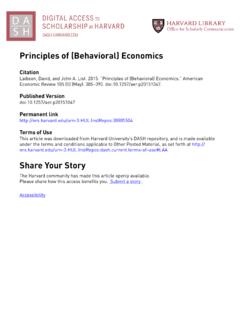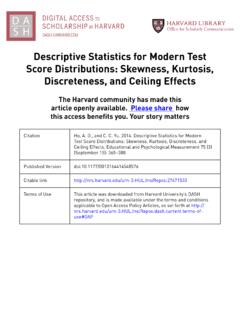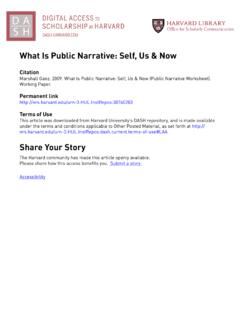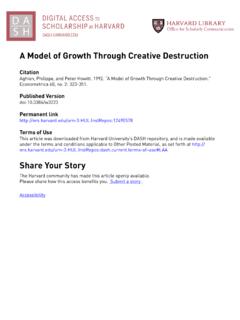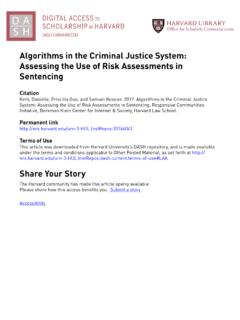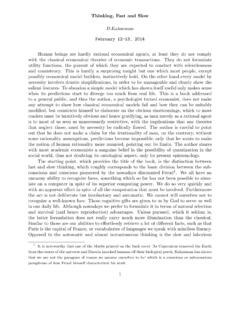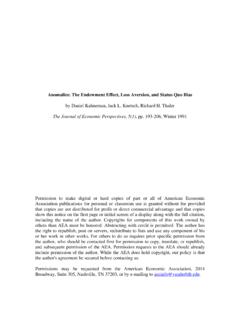Transcription of Psychologists at the Gate: Review of Daniel Kahneman’s ...
1 Psychologists at the gate : Review of DanielKahneman s thinking , fast and SlowThe Harvard community has made thisarticle openly available. Please share howthis access benefits you. Your story mattersCitationShleifer, Andrei. 2012. Psychologists at the gate : Review of DanielKahneman s thinking , fast and slow . Journal of EconomicLiterature 50(4): :10735580 Terms of UseThis article was downloaded from Harvard University s DASH repository, and is made available under the terms and conditionsapplicable to Open Access Policy Articles, as set forth at #OAP 1 Psychologists at the gate : Review of Daniel kahneman s thinking , fast and slow Andrei Shleifer1 August 2012 The publication of Daniel kahneman s book, thinking , fast and slow , is a major intellectual event. The book summarizes, but also integrates, the research that kahneman has done over the past 40 years, beginning with his path-breaking work with the late Amos Tversky. The broad theme of this research is that human beings are intuitive thinkers and that human intuition is imperfect, with the result that judgments and choices often deviate substantially from the predictions of normative statistical and economic models.
2 This research has had a major impact on psychology, but also on such diverse areas of economics as public finance, labor economics, development, and finance. The broad field of behavioral economics perhaps the most important conceptual innovation in economics over the last 30 years might not have existed without kahneman and Tversky s (hereafter, KT s) fundamental work. It certainly could not have existed in anything like its current form. The publication of kahneman s book will bring to an even broader audience of economists some of the most innovative and fundamental ideas of 20th century social science. In this Review , I discuss some broad ideas and themes of the book. Although it would be relatively easy to carry on in the spirit of the first paragraph, constrained only by my limited vocabulary of adjectives, I will seek to accomplish a bit more. First, because the book mentions few economic 1 Department of Economics, Harvard University.
3 I have benefitted from generous comments of Nicholas Barberis, Pedro Bordalo, Thomas Cunningham, Nicola Gennaioli, Matthew Gentzkow, Owen Lamont, Sendhil Mullainathan, Josh Schwartzstein, Jesse Shapiro, Tomasz Strzalecki, Dmitry Taubinsky, Richard Thaler, and Robert Vishny. They are not, however, responsible for the views expressed in this Review . I do not cite specific papers of kahneman when the material is described in the book. 2 applications, I will describe some of the economic research that has been substantially influenced by this work. My feeling is that the most profound influence of KT s work on economics has been in finance, on what has now become the field of behavioral finance taught in dozens of undergraduate and graduate economics programs, as well as at business schools. I learned about KT s work in the 1980s as a graduate student, and it influenced my own work in behavioral finance enormously. Second, I believe that while KT s work has opened many doors for economic research, some of the fundamental issues it raised remain work in progress.
4 I will thus discuss what kahneman s work suggests for decision theory, primarily as I see it through the lens of my recent work with Nicola Gennaioli and Pedro Bordalo (Gennaioli and Shleifer 2010, Bordalo, Gennaioli, and Shleifer 2012a,b,c). Before turning to the book, let me briefly address the two common objections to the introduction of psychology into economics, which have been bandied around for as long as the field has existed. The first objection holds that, while psychological quirks may influence individual decisions at the boundary, the standard economic model describes first order aspects of human behavior adequately, and economists should focus on first order things rather than quirks. Contrary to this objection, Della Vigna (2010) summarizes a great deal of evidence of large and costly errors people make in important choices. Let me illustrate. First, individuals pay large multiples of actuarially fair value to buy insurance against small losses, as well as to reduce their deductibles (Sydnor 2010).
5 In the standard model, such choices imply astronomical levels of risk aversion. Second, the standard economic view that persuasion is conveyance of information seems to run into a rather basic problem that advertising is typically emotional, associative, and misleading yet nonetheless effective (Bertrand et al. 2010, Della Vigna and Gentzkow 2010, Mullainathan et al. 2008). Third, after half a century of teaching by financial economists that investors should pick low-cost index funds, only a minority do, while most select high cost actively managed funds that underperform those index funds. These kinds of behavior matter for 3 both prices and resource allocation. Explaining such behavior with the standard model is possible, but requires intellectual contortions that are definitely not first order. The second objection holds that market forces eliminate the influence of psychological factors on prices and allocations.
6 One version of this argument, made forcefully by Milton Friedman (1953) in the context of financial markets, holds that arbitrage bring prices and therefore resource allocation to efficient levels. Subsequent research has shown, however, that Friedman s argument while elegant is theoretically (and practically) incorrect. Real-world arbitrage is costly and risky, and hence limited (see, , Grossman and Miller 1988, DeLong et al 1990, Shleifer and Vishny 1997). Dozens of empirical studies confirm that, even in markets with relatively inexpensive arbitrage, identical, or nearly identical, securities trade at different prices. With costlier arbitrage, pricing is even less efficient. A second version of the forces of rationality objection holds that participants in real markets are specialists invulnerable to psychological quirks. John List s (2003) finding that professional baseball card traders do not exhibit the so-called endowment effect is supportive of this objection.
7 The problem with taking this too far is that individuals make lots of critical decisions how much to save, how to invest, what to buy on their own, without experts. Even when people receive expert help, the incentives of experts are often to take advantage of psychological biases of their customers. Financial advisors direct savers to expensive, and often inappropriate, products, rather than telling them to invest in index funds (Chalmers and Reuter 2012, Gennaioli et al. 2012). Market forces often work to strengthen, rather than to eliminate, the influence of psychology. 4 I. System 1 and System 2. kahneman s book is organized around the metaphor of System 1 and System 2, adopted from Stanovich and West (2000). As the title of the book suggests, System 1 corresponds to thinking fast , and System 2 to thinking slow . kahneman describes System 1 in many evocative ways: it is intuitive, automatic, unconscious, and effortless, it answers questions quickly through associations and resemblances, it is non-statistical, gullible, and heuristic.
8 System 2 in contrast is what economists think of as thinking : it is conscious, slow , controlled, deliberate, effortful, statistical, suspicious and lazy (costly to use). Much of KT s research deals with system 1 and its consequences for decisions people make. For kahneman , System 1 describes normal decision making. System 2, like the US Supreme Court, checks in only on occasion. kahneman does not suggest that people are incapable of System 2 thought and always follow their intuition. System 2 engages when circumstances require. Rather, many of our actual choices in life, including some important and consequential ones, are System 1 choices, and therefore are subject to substantial deviations from the predictions of the standard economic model. System 1 leads to brilliant inspirations, but also to systematic errors. To illustrate, consider one of KT s most compelling questions/experiments: An individual has been described by a neighbor as follows: Steve is very shy and withdrawn, invariably helpful but with very little interest in people or in the world of reality.
9 A meek and tidy soul, he has a need for order and structure, and a passion for detail. Is Steve more likely to be a librarian or a farmer? Most people reply quickly that Steve is more likely to be a librarian than a farmer. This is surely because Steve resembles a librarian more than a farmer, and associative memory quickly creates a 5 picture of Steve in our minds that is very librarian-like. What we do not think of in answering the question is that there are 5 times as many farmers as librarians in the US, and that the ratio of male farmers to male librarians is even higher (this certainly did not occur to me when I first read the question many years ago, and does not even occur to me now as I reread it, unless I force myself to remember). The base rates simply do not come to mind and thus prevent an accurate computation and answer, namely that Steve is more likely to be a farmer.
10 System 2 does not engage. In another example (due to Shane Frederick), one group of respondents is asked (individually) to estimate the total number of murders in Detroit in a year. Another group is asked to estimate the total number of murders in Michigan in a year. Typically, the first group on average estimates a higher number of murders than the second. Again, System 1 thinking is in evidence. Detroit evokes a violent city, associated with many murders. Michigan evokes idyllic apple-growing farmland. Without System 2 engagement, the fact that Detroit is in Michigan does not come to mind for the second group of respondents, leading across subjects to a dramatic violation of basic logic. kahneman s other examples of System 1 thinking include adding 2 + 2, completing the words bread and .., and driving a car on an empty road. Calling all these examples System 1 thinking captures the rapid, intuitive, automatic response, which usually gets the right answer, but sometimes as with Steve and murders in Michigan does not.
